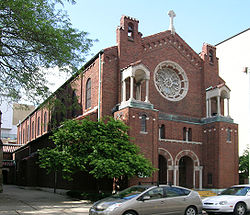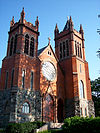- Chapel of St. Theresa-the Little Flower
-
Chapel of St. Theresa - the Little Flower (St. Patrick Church)
 St. Patrick Church
St. Patrick ChurchLocation: 58 Parsons Street
Detroit, Michigan 48201 United States
United StatesCoordinates: 42°20′54″N 83°3′36″W / 42.34833°N 83.06°WCoordinates: 42°20′54″N 83°3′36″W / 42.34833°N 83.06°W Built: 1926 Architect: Donaldson and Meier Architectural style: Late 19th And 20th Century Revivals, Late Victorian, Romanesque Governing body: Private MPS: Cass Farm MPS NRHP Reference#: 97001099[1] Added to NRHP: September 22, 1997 The Chapel of St. Theresa-the Little Flower is a church located at 58 Parsons Street in Detroit, Michigan. It is currently known as St. Patrick Church. The building was listed on the National Register of Historic Places in 1997.[1]
Contents
History
St. Patrick Parish began in 1862, in response to the influx of Irish Catholics into Detroit.[2] The parish built a chapel on Adelaide near John R Street, which was eventually expanded into a church. St. Patrick's became one of Detroit’s largest and wealthiest parishes, although the church was never one of Detroit's largest or most impressive. In 1890, the church was named the cathedral of the diocese and was renamed in honor of Sts. Peter and Paul as the prior cathedral church on East Jefferson had been. Bishop Caspar Borgess gave the old Sts. Peter and Paul to the Jesuits in 1877 after he moved to the new cathedral.[2] In 1892, to serve the children of the community, the Sts. Peter and Paul Academy was built on Parsons west of Woodward, which was some distance away from the main church.[2]
By the 1920s, the streets in the area had become so busy that the trek from church to school was considered unsafe for children going to school Masses.[2] As a remedy, the parish constructed the Chapel of St. Theresa, the Little Flower in 1927,[2] naming the chapel after Thérèse de Lisieux.[3] In 1938, the cathedral function was transferred to Blessed Sacrament parish and St. Patrick's reverted to its original name. As the years passed, the area around the original St. Patrick church steadily declined, and more activities were held in the chapel and school.[2] All activities were moved to Parsons Street in the 1980s and the old church was given to a community group. Essentially abandoned for a number of years, it was then vandalized and eventually burned in 1992. [2]
Architecture
The chapel is in the Romanesque Revival style with a basilica floorplan. It is constructed of red brick with limestone accents and a red tile roof. The entrance is recessed in twin arches framed by square bays. The bays are each topped by a limestone portico consisting of a barrel vault supported by four Corinthian columns. The gabled roofs of the porticoes are covered with red tile matching the other portions of the roof. Above the entry doors on the clerestory level are small arched windows and above the clerestory is a small rose window. Above the porticos are two small campanarios each holding a bell.[3]
See also
- Archdiocese of Detroit
References
- ^ a b "National Register Information System". National Register of Historic Places. National Park Service. 2008-04-15. http://nrhp.focus.nps.gov/natreg/docs/All_Data.html.
- ^ a b c d e f g Chapel of St. Theresa, the Little Flower from the city of Detroit
- ^ a b Chapel of Saint Theresa – the Little Flower from Detroit1701.org
Further reading
- Godzak, Roman (2000). Archdiocese of Detroit (Images of America). Arcadia Publishing. ISBN 0738507972.
- Godzak, Roman (2004). Catholic Churches of Detroit (Images of America). Arcadia Publishing. ISBN 0738532355.
- Godzak, Roman (2000). Make Straight the Path: A 300 Year Pilgrimage Archdiocese of Detroit. Editions du Signe. ISBN 2746801450.
- Tentler, Leslie Woodcock with forward by Edmund Cardinal Szoka (1992). Seasons of Grace: A History of the Catholic Archdiocese of Detroit. Wayne State University Press. ISBN 0814321062.
- Tutag, Nola Huse with Lucy Hamilton (1988). Discovering Stained Glass in Detroit. Wayne State University Press. ISBN 0-8143-1875-4.
External links
- St. Patrick home page
- St. Patrick parish from the archdiocese of Detroit
U.S. National Register of Historic Places Topics Lists by states Alabama • Alaska • Arizona • Arkansas • California • Colorado • Connecticut • Delaware • Florida • Georgia • Hawaii • Idaho • Illinois • Indiana • Iowa • Kansas • Kentucky • Louisiana • Maine • Maryland • Massachusetts • Michigan • Minnesota • Mississippi • Missouri • Montana • Nebraska • Nevada • New Hampshire • New Jersey • New Mexico • New York • North Carolina • North Dakota • Ohio • Oklahoma • Oregon • Pennsylvania • Rhode Island • South Carolina • South Dakota • Tennessee • Texas • Utah • Vermont • Virginia • Washington • West Virginia • Wisconsin • WyomingLists by territories Lists by associated states Other  Category:National Register of Historic Places •
Category:National Register of Historic Places •  Portal:National Register of Historic Places
Portal:National Register of Historic PlacesReligious landmarks in metropolitan Detroit Woodward Avenue
(address #)St. John's Episcopal Church (2326) • Woodward Avenue Baptist Church (demolished) • First Unitarian Church (2870) • First Presbyterian Church (2930) • Temple Beth-El (3424) • Cathedral Church of St. Paul (4800) • Our Lady of the Rosary (5930) • Metropolitan United Methodist Church (8000) • First Baptist Church (8501) • Woodward Avenue Presbyterian Church (8501) • North Woodward Congregational Church (8715) • Temple Beth-El (8801) • Saint Joseph's Episcopal Church (8830) • Central Woodward Christian Church (9000) • Cathedral of the Most Blessed Sacrament (9844) • Grace Evangelical Lutheran Church (12375) • Trinity United Methodist Church (13100) • First United Methodist Church (16300) • Central United Methodist Church (23 East Adams) • First Congregational Church (33 Forest) • Highland Park Presbyterian Church (14 Cortland) • Mariners' Church (170 East Jefferson)

City Assumption of the Blessed Virgin Mary Church • Cass Avenue Methodist Episcopal Church • Chapel of St. Theresa-the Little Flower • Christ Church Detroit • Fort Street Presbyterian Church • Gethsemane Evangelical Lutheran Church • Historic Trinity Lutheran Church • Jefferson Avenue Presbyterian Church • Most Holy Redeemer Church • Sacred Heart Major Seminary • Sacred Heart Roman Catholic Church, Convent and Rectory • St. Albertus Roman Catholic Church • St. Aloysius • Saint Andrew's Memorial Episcopal Church • Ste. Anne de Detroit Catholic Church • St. Boniface Roman Catholic Church (demolished) • St. Bonaventure Monastery • St. Catherine of Siena Roman Catholic Church • St. Charles Borromeo Roman Catholic Church • St. Florian Church (Hamtramck) • St. James Episcopal (Grosse Ile) • St. John's-St. Luke's Evangelical • St. Josaphat's • St. Joseph Catholic Church • St. Mary Roman Catholic Church • Saints Peter and Paul Church • Saints Peter and Paul Academy • St. Stanislaus Bishop and Martyr Roman Catholic Church • St. Theresa of Avila Roman Catholic Church • St. Thomas the Apostle Catholic Church (demolished) • Second Baptist Church • Sweetest Heart of Mary Roman Catholic Church • Trinity Episcopal Church • Trumbull Avenue Presbyterian Church
Suburban Christ Church Chapel (Grosse Pointe) • Christ Church Cranbrook (Bloomfield Hills) • Detroit Temple, Church of the Latter Day Saints (Bloomfield Hills) • Duns Scotus College (Southfield) • Grosse Pointe Memorial Church (Grosse Pointe) • Islamic Center of America (Dearborn) • Kirk in the Hills (Bloomfield Hills) • National Shrine of the Little Flower (Royal Oak) • Nardin Park United Methodist Church (Farmington Hills) • Piety Hill Historic District (Lapeer) • St. John Armenian Church (Southfield) • St. Mary Church (Monroe) • Saint Paul Catholic Church (Grosse Pointe Farms) • Shaarey Zedek (Southfield) • Temple Beth El(Bloomfield Hills)
See also: Architecture of metropolitan Detroit Cass Farm Multiple Property Submission Cass-Davenport Historic District • Chapel of St. Theresa-the Little Flower • Detroit Edison Company Willis Avenue Station • Detroit-Columbia Central Office Building • Graybar Electric Company Building • Hotel Stevenson • Robert M. and Matilda (Kitch) Grindley House • League of Catholic Women Building • Saints Peter and Paul Academy • Warren-Prentis Historic District • West Canfield Historic District (Boundary Increase) • Willis-Selden Historic DistrictCategories:- Churches in Detroit, Michigan
- Properties of religious function on the National Register of Historic Places in Michigan
- Religious buildings completed in 1926
- 20th-century Roman Catholic church buildings
- Roman Catholic churches in Michigan
- Romanesque Revival architecture in Michigan
- Religious organizations established in 1862
Wikimedia Foundation. 2010.
